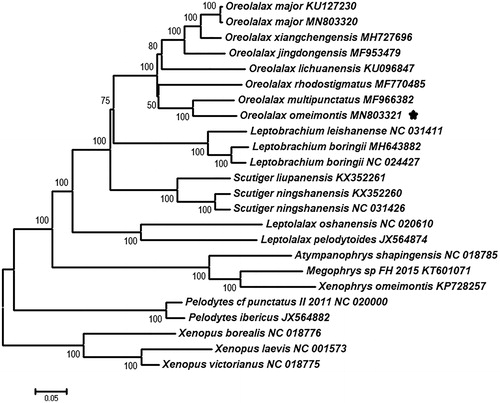Abstract
We sequenced and annotated the complete mitogenome sequence of Oreolalax omeimontis (17,675 bp long). The mitogenome encoded 13 protein-coding genes (PCG), 2 ribosomal RNA (rRNA) genes, 23 transfer RNA (tRNA) genes, and a control region (GenBank accession number MN803321). The phylogenetic tree conforms the close relationship of O. omeimontis and O. multipunctatus, and a monophyletic clade of genus Oreolalax.
The toothed toad, genus Oreolalax, belonging to the family Megophryidae, comprises 19 species distributed in southwestern China and adjacent Vietnam (Frost Citation2020), and 18 that are distributed in China (AmphibiaChina Citation2020). The large toothed toad (Oreolalax omeimontis) is found only in montane regions of central Sichuan (Emei and Hongya Counties), China (Fei et al. Citation2012; Frost Citation2020) at the elevation from 1050 to 1800 m. Recently, Huang et al. reported a compete mitogenome of Oreolalax major and provided neighbor-joining tree of the Oreolalax (Huang et al. Citation2020). To date, only seven Oreolalax species mitogenome sequences are available from NCBI GenBank (see ). In this study, a complete mitogenome of O. omeimontis was sequenced, which will provide insights into mitogenome evolution and explore the phylogenetic relationship of Oreolalax.
Figure 1. Neighbour-joining (NJ) phylogenetic tree based on all 13 combined mitochondrial protein-coding genes from 21 species. The numbers of internal branches are bootstrap values.

The specimen of O. omeimontis was collected from Wawushan Nature Reserve (29°40′2.89″N, 102°58′28.86″E., elev. 1400 m), Sichuan Province, China, in 2015, which was deposited in the Museum of Sichuan Agricultural University (Specimen voucher: 20120084). Total genomic DNA was extract from ethanol-preserved muscle tissue by using the Ezup pillar genomic DNA extraction kit (Sangon Biotech, Shanghai, China). The whole genome library was constructed and sequenced on an Illumina MiSeq platform (PE400) by Personal Biotechnology (Shanghai, China).
The closed-circular mitogenome (MN803321) of O. omeimontis contained 38 genes including 13 protein-coding genes (PCGs), 2 ribosomal RNA (rRNA) genes, 23 tRNA genes (including two trnM genes) and a control region (D-loop). The total mitogenome length of O. omeimontis is 17,675 bp, and the base composition of the mitogenome is 28.46% A, 13.99% G, 24.96% C, 32.59% T, respectively. Comparative analysis indicates that the mitogenome structure of O. omeimontis is similar to that of other Megophryidae (Xiang Citation2013; Liang Citation2016; Liang et al. Citation2016). Nad6 and eight tRNAs (tRNA-Q, A, N, C, Y, S2, E and P) are located on the L-light strand (L strand), and the others are encoded on the heavy strand (H strand). Most of the PCGs (nine) were started by ATG, except two PCGS (cox1 and nad4l) by GTG, and nad3 by ATA. Nad1 was terminated by TAG, three PCGs (cox1, nad5 and nad6) terminated by AGG as termination codon, and four (nad2, atp8, nad3 and nad4l) terminated by TAA. Two PCGs (atp6 and cox3) stopped with TA, whereas three (cox2, nad4 and cytb) stopped with a single base T. The length of 12S and 16S rRNA are 936 and 1589 bp respectively. The length of mitogenome ranges from 17,110 bp in O. xiangchengensis to 18,676 bp in O. rhodostigmatus. The small differences in size between Oreolalax mitogenome was largely due to an expansion of control region (Huang et al. Citation2020).
The final alignment consisted of 24 sequences of 21 species from nine genera (Oreolalax, Leptobrachium, Scutiger, Leptolalax, Atympanophrys, Megophrys, Xenophrys, Pelodytes, and Xenopus). Phylogenetic trees of the family Megophryidae were reconstructed by MEGA7.0 (Kumar et al. Citation2016) using 13 combined PCGs with three Xenopus species as outgroups. The close relationship of O. omeimontis and O. multipunctatus, and a monophyletic clade of genus Oreolalax were confirmed by 100% bootstrap support (). More mitogenome sequences of other Oreolalax species are needed and that would be useful to understand molecular evolution and elucidate phylogenetic relationships among Oreolalax.
Acknowledgments
Thanks to Fuyao Han in our lab for her help in data analysis.
Disclosure statement
No potential conflict of interest was reported by the author(s).
Data availability statement
The data used to support the findings of this study are available in MITOS WebServer at http://mitos2.bioinf.uni-leipzig.de/overview.py?hash=tZY1Qh2i or in GenBank at https://www.ncbi.nlm.nih.gov/nuccore/MN803321, reference number MN803321.
Additional information
Funding
References
- AmphibiaChina. 2020. The database of Chinese amphibians. Kunming, China: Kunming Institute of Zoology (CAS). http://www.amphibiachina.org/.
- Fei L, Ye C, Jiang J. 2012. Colored Atlas of Chinese amphibians and their distributions. Chengdu: Sichuan Publishing House of Science and Technology.
- Frost D. 2020. Amphibian species of the world: an online reference. Version 6.0. New York: American Museum of Natural History. http://research.amnh.org/herpetology/amphibia/index.html.
- Huang T, Cui L, Li D, Fan X, Yang M, Yang D, Ni Q, Li Y, Yao Y, Xu H, et al. 2020. The complete mitogenome of the large toothed toad, Oreolalax major (Anura: Megophryidae) with phylogenetic analysis. Mitochondrial DNA Part B. 5(1):1117–1118.
- Kumar S, Stecher G, Tamura K. 2016. MEGA7: molecular evolutionary genetics analysis version 7.0 for bigger datasets. Mol Biol Evol. 33(7):1870–1874.
- Liang X. 2016. Structure and evolution of mitochondrial genomes of megophryidae. [PhD Dissertation]. Beijing: University of Chinese Academy of Sciences .
- Liang X, Wang B, Li C, Xiang T, Jiang J, Xie F. 2016. The complete mitochondrial genome of Oreolalax major (Anura: Megophryidae). Mitochondrial DNA Part B. 1(1):118–119.
- Xiang T. 2013. Analysis of complete mitochondrial genomes in representative species of three subfamilies of Megophryidae (Amphibia, Anura). [PhD Dissertation]. Beijing: University of Chinese Academy of Sciences.
